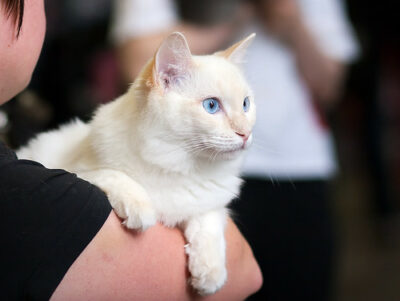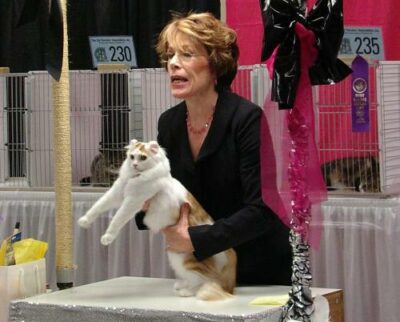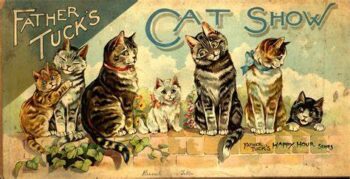How did it all start? Long ago, those who loved cats wanted to let the world know about their fur babies. Somewhere, back then, when someone said, “Show me your cat,” another responded, “Look at this beautiful creature.”
Early Cat Shows
People take pride in this small animal that has become part of the family. According to my sources, the very first cat show took place at the Giles Fair in Winchester, England, in 1598.
Other small shows probably took place over the years, but the event that truly launched the popularity of cat shows was one that took place in July, 1871, at London’s Crystal Palace. This show featured a national competition, and who among cat enthusiasts could resist such a challenge?
Then, in 1889, Harrison Weir, an artist who also carried the moniker of “Father of Cat Fancy”, authored the first pedigree cat book, “Our Cats and All About Them.” He founded the UK’s National Cat Club and set the first standards for specific cat beeeds.
Though Harrison Weir gains credit for organizing the Crystal Palace show, other accounts state that Fred Wilson, a naturalist who worked as superintendant at the Natural History Department at the Crystal Palace, did much of the planning.

This show could be considered a success, as it reportedly showcased between 150 and 211 exotic cats. As many as 200,000 guests supposedly attended. Cats such as Siamese, Manx, Persion, and English Shorthairs appeared at the show, along with some unusual felines.
Newspapers mentioned a Scottish Wildcat, owned by the Duke of Sutherland, an Algerian cat, listed as a French African cat, a polydactyl with 26 claws, and a tortoiseshell.
Success Prompted A Second Show
The success of this large show prompted Weir to organize another Crystal Palace cat show a few months later. From these shows came the first manual for cat show organizers, which included guidelines for judging.
Participating cats became sorted into different classes according to color, shape, coat length, and body type. The cats that best fit Weir’s criteria received awards.
The second show encouraged working-class folks to submit their ordinary domestic cats. This exhibit ended up showing many more kitties then the first one, and the added judges gave trophies to both pedigreed and “working men’s cats.”
Popularity Spreads
The cat shows spread through Europe, and several more of these shows appeared. Then, in 1895, the first well-known cat show occurred in America, held in New York City’s Madison Square Garden.
Now, these events have developed into the multitude of cat shows that we have today. Each country has its own breed standards and each cat group its own set of rules and regulations, making one cat show a bit different from aonther, depending on location and organizer.
The cat show season runs from May through the following April. The show might last one day or two, and will usually draw large crowds.
Breed registries sponsor these shows, and it becomes their job to keep records of the cats’ pedigrees. The three best-known registries are the Cat Fanciers Association, the International Cat Association, and in the United States only, the American Cat Fanciers Association. Clubs affiliated with these registries host the shows.
If you wish to enter your cat in a show, submit your entry early, as the information will go into a show catalog and judge’s book. These become used for rewarding points.
Before The Show Starts
Backstage, each cat has his own cage which has curtains around it. These have the importance of keeping cats from seeing each other and becoming too excited before the show starts. Inside, the cage has food and water, a bed, and a litter box.
Each cat has an assigned number. When this number is called over the loudspeaker, the cat and owner go to one of 8 to 12 rings, where a judge will take each cat, one at a time, from its cage and look for the characteristics outlined in the written standards for that breed.
These standards include head shape, bone structure, coat color and texture, and overall health. The judge also looks for cats with a calm, happy personality.

The judging takes place in all rings at the same time. The judge awards points to each cat. She then selects the top 10 in her ring and the Best In Show.
Points are tallied, and the presiding judge announces the winner.
Thus, the cat does not compete against other cats in the show, but rather against the written standards for their breed.
Are There Monetary Rewards?
Competing in cat shows does not offer monetary prizes. It’s more about comparison to other cats in the breed, and for professional breeders, to learn how to improve their breeding programs. The shows can also go a long way toward educating the general public about breeds and proper care.
If you think you’d like to enter your cat in a show, do some homework. For starters, attend a show so you can learn what goes on. Do some research to learn more about the information that’s out there about cats.
Do You Think Your Cat Could Handle A Show?
What about your cat? Can a stranger handle him? Many cats do well in a show because they have been socialized and trained since kittenhood to deal with the stressful factors that may arise.
How about loud noises, or crowds, or children? Do you have the original laid-back cat? Make sure you and your cat can prepare adequately for this adventure.
After all, your cat’s personality and reaction to such an event could have a lasting effect on kitty. Make sure your cat is well-prepared for such an event, and keep his/her welfare at the forefront.
References I used for this post:
animals.howstuffworks.com/pets/cat-show.htm lovetoknowpets.com/life-with-pets/how-cat-shows-work mentalfloss.com/article/72203/brief-fur-filled-history-cat-shows http://lifeandcats.com/how-cat-shows-work-faq/


What a fabulous entry! I was blown away by the fact that you found a cat show that took place in 1598! I am very tempted to used that in a time-traveling Sphynx story, so I’m digging around in the research.
It was an amazing coincidence that an early modern show took place at the Crystal Palace. For some reason or other the Crystal Palace, and the Great Exhibition have been in books I’ve been reading lately, so this was a juicy bit.
I love The Literate Cat and get ideas and so much enjoyment from it! I look forward to each new feature.
Mary, I loved your comment and so glad you love the site. While you are getting ideas, if you come up with some you’d like me to write about in the website, please let me know.For now, trying hard to think of a question to ask my clowder in my Facebook group. Keep reading and commenting — you give me a great boost.